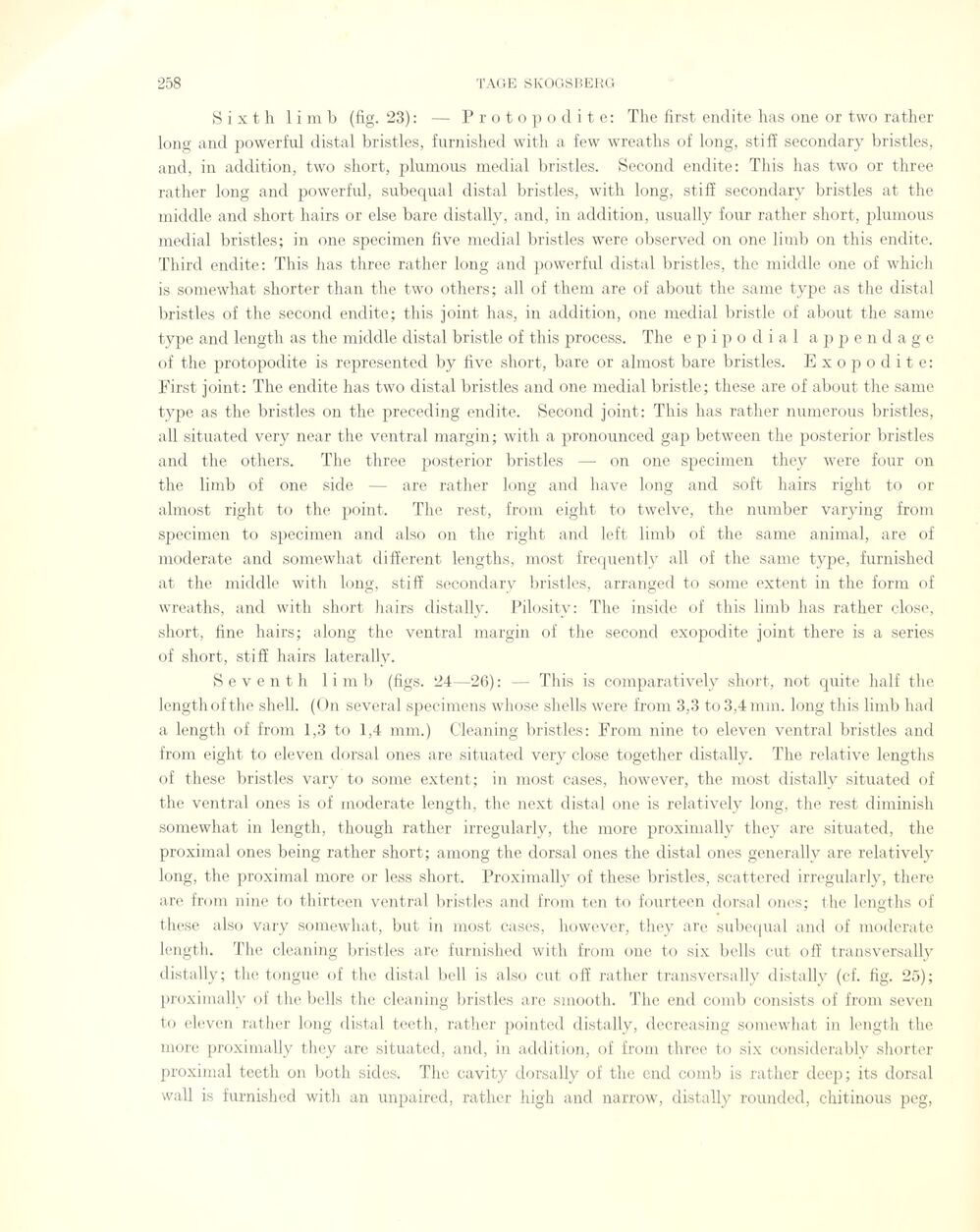
Full resolution (JPEG) - On this page / på denna sida - Sidor ...

<< prev. page << föreg. sida << >> nästa sida >> next page >>
Below is the raw OCR text
from the above scanned image.
Do you see an error? Proofread the page now!
Här nedan syns maskintolkade texten från faksimilbilden ovan.
Ser du något fel? Korrekturläs sidan nu!
This page has never been proofread. / Denna sida har aldrig korrekturlästs.
S i X t h 1 i m b (fig. 23) : — Protopodite: The first endite has one or two rather
long and powerful distal bristles, furnished with a few wreaths of long, sti fif secondary bristles,
and, in addition, two short, plumous medial bristles. Second endite: This has two or three
rather long and powerful, subequal distal bristles, with long, stiff secondary bristles at the
middle and short hairs or else bare distally, and, in addition, usually four rather short, plumous
medial bristles; in one specimen five medial bristles were observed on one li mb on this endite.
Third endite: This has three rather long and powerful distal bristles, the middle one of which
is somewhat shorter than the two others; all of them are of about the same type as the distal
bristles of the second endite; this joint, has, in addition, one medial bristle of about the same
type and length as the middle distal bristle of this process. The. epipodial appendage
of the protopodite is represented by five short, bare or almost bare bristles. Exop odite:
First joint: The endite has two distal bristles and one medial bristle; these are of about the same
type as the bristles on the preceding endite. Second joint: This has rather numerous bristles,
all situated very near the ventral margin; with a pronounced gap between the posterior bristles
and the others. The three posterior bristles — on one specimen they were four on
the limb of one side — are rather long and have long and soft hairs right to or
almost right to the point. The rest, from eight to twelve, the number varying from
specimen to specimen and also on the right and left limb of the same animal, are of
moderate and somewhat different lengths, most frequently all of the same type, furnished
at the middle with long, stiff secondary bristles, arranged to some extent in the form of
wreaths, and with short hairs distally. Pilosity: The inside of this limb has rather close,
short, fine hairs; along the ventral margin of the second exopodite joint there is a series
of short, stiff hairs laterally.
Se venth lim b (figs. 24—26) : — This is comparatively short, not quite half the
length of the shell. (On several specimens whose shells were from 3,3 to 3,4 mm. long this limb had
a length of from 1,3 to 1,4 mm.) Cleaning bristles: From nine to eleven ventral bristles and
from eight to eleven dorsal ones are situated very close together distally. The relative lengths
of these bristles vary to some extent; in most cases, however, the most distally situated of
the ventral ones is of moderate length, the next distal one is relatively long, the rest diminish
somewhat in length, though rather irregularly, the more proximally they are situated, the
proximal ones being rather short; among the dorsal ones the distal ones generally are relativel)’
long, the proximal more or less short. Proximally of these bristles, scattered irregularly, there
are from nine to thirteen ventral bristles and from ten to fourteen dorsal ones; the lengths of
these also vary somewhat, but in most cases, however, they are subequal and of moderate
length. The cleaning bristles are furnished with from one to six bells cut off transversally
distally; the tongue of the distal bell is also cut off rather transversally distally (cf. fig. 25);
proximally of the bells the cleaning bristles are smooth. The end comb consists of from seven
to eleven rather long distal teeth, rather pointed distally, decreasing somewhat in length the
more proximally they are situated, and, in addition, of from three to six considerably shorter
proximal teeth on both sides. The cavity dorsally of the end comb is rather decp; its dorsal
wall is furnished with an unpaired, rather high and narrow, distally rounded, chitinous peg,
<< prev. page << föreg. sida << >> nästa sida >> next page >>